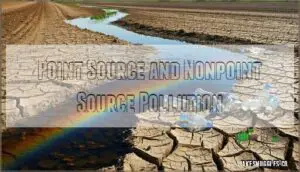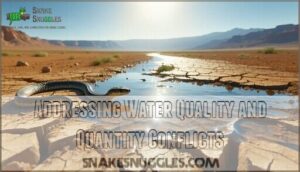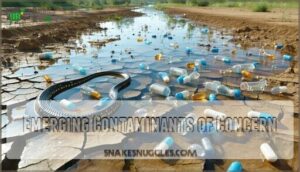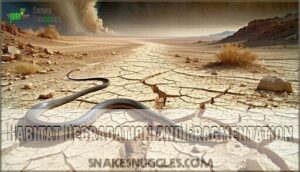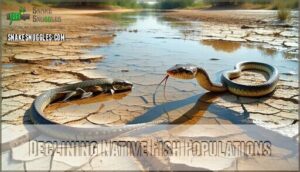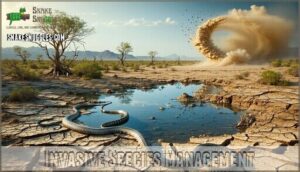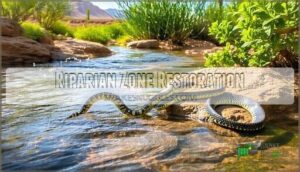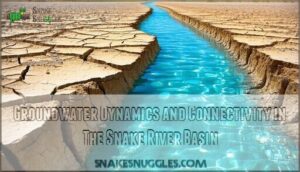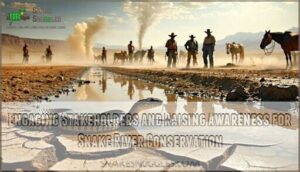This site is supported by our readers. We may earn a commission, at no cost to you, if you purchase through links.
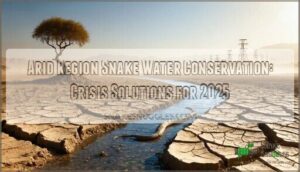
Overallocation means there’s simply not enough water to go around, leaving rivers running dangerously low and ecosystems struggling to survive.
Smart irrigation systems, drought-resistant crops, and conjunctive management of groundwater and surface water can stretch every drop further.
Think of it like managing a household budget during tough times—you’ve got to prioritize essentials while finding creative ways to make resources last.
The key to arid region snake water conservation lies in balancing human needs with ecological health through innovative technology and collaborative planning.
There’s more to this puzzle than meets the eye.
Table Of Contents
- Key Takeaways
- Water Rights and Allocation in Arid Snake River Basin
- Pollution and Water Quality Challenges in The Snake River
- Restoring and Conserving The Snake River Ecosystem
- Groundwater Dynamics and Connectivity in The Snake River Basin
- Engaging Stakeholders and Raising Awareness for Snake River Conservation
- Advancing Research and Data-Driven Decision-Making for The Snake River
- Frequently Asked Questions (FAQs)
- Where do snakes get water in the desert?
- Do snakes need water to live?
- What is the impact of evaporation on water conservation?
- How do climate shifts affect the Snake Rivers flow?
- What innovative technologies support water conservation?
- How does sedimentation impact the Snake Rivers health?
- How can riparian areas be preserved and enhanced?
- How do desert snakes detect underground water sources?
- What triggers estivation behavior in drought conditions?
- Can snakes absorb water directly through skin?
- Conclusion
Key Takeaways
- You’ll maximize water efficiency by implementing smart irrigation systems and drought-resistant crops – these technologies can reduce water usage by 30% while maintaining agricultural productivity in water-scarce environments.
- You need to manage groundwater and surface water as one connected system – conjunctive management approaches help you store excess water underground during wet periods and access it during droughts, creating resilient water supplies.
- You can’t solve water quantity without addressing water quality issues simultaneously – pollution concentration increases when river flows drop, so you’ll need integrated treatment and conservation strategies that tackle both challenges together.
- You’ll achieve lasting conservation success through collaborative partnerships and stakeholder engagement – bringing together farmers, conservationists, policymakers, and communities creates shared responsibility and adaptive management strategies that protect both human needs and ecosystem health.
Water Rights and Allocation in Arid Snake River Basin
You’re facing a water crisis that’s been decades in the making – the Snake River Basin has more water rights on paper than actual water flowing through its channels.
This overallocation means that during dry years, there simply isn’t enough water to go around for farmers, cities, and the river’s ecosystem.
Overallocation of Water Rights
Looking at the Snake River basin, you’ll find historical overcommitment has created a perfect storm.
Water rights exceed actual river flows by 120-150% in some areas, leaving 250,000 acre-feet unmet during drought impacts.
This arid region faces water scarcity as senior rights holders clash with newer users.
Re-allocation strategies and groundwater sustainability measures offer hope for balancing usage through creative water conservation approaches.
Impacts of Overallocation on River Flows
When you’re dealing with overallocation in the Snake River Basin, flow reduction becomes your biggest headache.
Imagine this scenario: water scarcity hits like a sledgehammer, dropping river levels so dramatically that habitat loss becomes inevitable.
Fish can’t survive in shallow, overheated waters where temperature increase spikes dangerously.
The ecological consequences ripple through the entire arid region ecosystem, turning once-thriving waterways into struggling streams that can’t support wildlife or human needs.
Balancing Water Demands and Ecological Needs
Balancing competing water demands while protecting arid snake water conservation requires strategic thinking.
You’ll need to prioritize species water needs alongside human requirements, recognizing that creative re-allocation of existing water rights can ease pressure on ecosystems.
Drought-resistant crops and efficient irrigation help farmers adapt to water scarcity snakes face too.
Here’s how smart water allocation protects arid region wildlife:
- Habitat preservation through minimum flow requirements keeps riparian zones alive
- Conservation strategies that time water releases during critical breeding seasons
- Arid adaptations monitoring helps identify which snake survival arid methods work best
- Community partnerships create shared responsibility for ecosystem health
- Data-driven decisions balance agricultural needs with wildlife corridors
Getting locals involved makes all the difference.
Innovative Water Management Strategies
The Snake River Basin’s water management revolution centers on proven innovative strategies that deliver results.
Managed aquifer recharge pumps 250,000 acre-feet annually into underground storage, while precision irrigation and rotational fallowing cut consumption by 20%.
These water-wise practices mirror desert snakes’ physiological mechanisms – both maximize efficiency through behavioral adaptations.
Water banking reallocates 115,000 acre-feet yearly, and forecast-informed operations optimize releases using real-time data for enhanced metabolic efficiency.
Stakeholder Collaboration for Equitable Water Allocation
Water managers can’t just wing it when supplies run low. You need water negotiation skills and collaborative governance to bring farmers, conservationists, and policymakers together for conflict resolution and shared responsibility.
Effective stakeholder collaboration creates adaptive planning that works for everyone:
- Market-based water trading lets users buy and sell rights based on real needs
- Joint monitoring programs give local stakeholders shared data for better decisions
- Seasonal allocation agreements adjust water distribution as conditions change
The Idaho Conservation League shows how collaborative partnerships and community engagement deliver win-win water allocation solutions. Some states even have species limitations to protect both people and animals.
Pollution and Water Quality Challenges in The Snake River
When you examine the Snake River’s water quality, you’ll discover that pollution sources create a toxic cocktail that threatens both aquatic life and human communities downstream.
The river’s reduced flows can’t dilute contaminants effectively, turning what should be a natural cleansing process into a concentrated nightmare for ecosystem health.
Point Source and Nonpoint Source Pollution
You’re facing contamination from multiple angles in the Snake River.
Point source pollution flows directly from industrial discharges and wastewater treatment plants, while nonpoint source pollution spreads diffusely through agricultural runoff carrying pesticides and fertilizers.
Urban stormwater adds another layer of complexity.
Contaminant buildup occurs when insufficient water dilutes these pollutants.
Emerging contaminants like pharmaceuticals pose new challenges requiring innovative treatment technologies and thorough pollution control strategies to address water scarcity and maintain water quality.
Impacts of Insufficient Dilution Flows
During dry spells, the Snake River can’t flush away pollution like it should.
Contaminant buildup creeps in, leaving less oxygen for aquatic life and making water safety a real concern.
It’s like a desert snake searching for a shrinking water source—adaptation is key.
Smarter treatment methods and flow regulation act as lifelines, restoring balance and supporting healthy snake drinking habits in arid climates.
Addressing Water Quality and Quantity Conflicts
The battle between water quality and quantity creates a perfect storm for ecosystems.
You can’t solve one without addressing the other – they’re interconnected like desert snake hydration and survival strategies.
Integrated Approaches That Actually Work:
- Flow regulation maintains dilution capacity while meeting ecological needs
- Demand reduction through water conservation eases pressure on both fronts
- Smart water usage timing aligns with natural flow patterns
- Cross-sector collaboration brings stakeholders together for solutions
- Adaptive management adjusts strategies based on real-time data
Think of it like snake adaptation desert styles – multiple strategies working together for water scarcity survival.
Emerging Contaminants of Concern
Looking beyond traditional pollutants, you’ll find a cocktail of emerging contaminants threatening Snake River’s arid ecosystem snake habitats.
Pharmaceutical Impacts disrupt fish reproduction, while Microplastic Threats infiltrate food webs. PFAS Risks persist in sediments for decades, and pesticides from agricultural runoff create toxic hotspots.
Don’t panic – knowledge is power! Understanding these water quality challenges helps protect both wildlife and communities facing water scarcity.
Snake adaptation desert strategies become compromised when emerging contaminants alter water chemistry and prey availability.
Innovative Treatment and Monitoring Approaches
Advanced filtration systems and real-time sensors revolutionize Snake River’s pollution fight.
These innovative strategies mirror snake water conservation mechanisms—just like water retention snake adaptations in arid climate snake habitats help snake physiology water management.
- Advanced Filtration: Membrane bioreactors remove 99% of contaminants
- Real-time Sensors: Monitor water quality every 15 minutes automatically
- Bioremediation Techniques: Bacteria naturally break down pollutants faster
- Remote Sensing: Satellites track pollution sources across entire watersheds
- Data Analytics: AI predicts contamination events before they happen
These systems often require specialized product sourcing for peak performance.
Restoring and Conserving The Snake River Ecosystem
You’re witnessing one of North America’s most critical ecosystem restoration challenges as the Snake River’s habitat faces unprecedented fragmentation and species decline.
The good news is that targeted conservation efforts combining riparian restoration with invasive species management are already showing promising results across the basin, highlighting the importance of ecosystem restoration.
Habitat Degradation and Fragmentation
Picture standing where lush riparian zones once thrived—now you’re seeing fragmented patches scattered across the landscape.
Habitat degradation in arid regions creates serious connectivity disruption for arid climate snake species and arid land reptiles.
This biodiversity decline threatens water conservation snake populations that depend on connected corridors.
Effective habitat restoration and conservation strategies focus on rebuilding these important links between fragmented areas.
Declining Native Fish Populations
Native fish populations in the Snake River face a perfect storm of challenges that’s decimating their numbers.
You’re witnessing species that once thrived now struggling to survive in dramatically altered conditions.
Here’s what’s driving this decline:
- Habitat Loss – Over 100 dams block access to 5,000 miles of historical spawning grounds
- Rising Temperatures – Heat events killed 250,000 salmonids in 2015 alone
- Dam Impacts – Fish passage survival drops below 55% at some facilities
- Flow Reduction – Summer flows decreased 60% since the 1950s
- Disease Outbreaks – Pathogen prevalence increased 300% since mid-1990s
These factors mirror challenges desert reptile water conservation faces – both require adaptive strategies for survival in harsh conditions.
The river’s ecosystem also supports various snake species, requiring slow river flow for ideal habitats.
Invasive Species Management
You’re facing a biological arms race where invasive species outcompete natives through Species Competition and Predation Impacts.
These invaders cause Habitat Alteration in arid environments, threatening snake conservation efforts.
Control Methods include targeted removal and biocontrol agents, while Prevention Strategies focus on early detection systems.
Invasive species control requires monitoring entry points and educating anglers about transport restrictions.
Success depends on rapid response teams that can tackle habitat degradation before it becomes irreversible.
Riparian Zone Restoration
You’ll transform degraded streambanks into thriving wildlife habitat through strategic native plantings.
These riparian zones provide erosion control while boosting water quality and biodiversity benefits.
Just like desert snake diet relies on moisture-rich prey, restored corridors support water source snake populations and reptile conservation water needs.
Consider selecting proper species for ideal restoration.
Community involvement makes snake behavior arid adaptation studies possible, creating resilient ecosystems.
Collaborative Conservation Initiatives
While riparian restoration rebuilds habitat foundations, lasting success requires unified action across communities.
Collaborative conservation initiatives bring together unlikely allies who share common goals.
Your conservation partnerships can amplify impact through coordinated efforts:
- Community stewardship programs connect neighbors with local watersheds, creating emotional bonds that drive long-term protection
- Water sharing agreements between ranchers and wildlife agencies prove that compromise benefits everyone’s bottom line
- Cross-sector collaboration unites government, nonprofits, and businesses around shared snake water strategy solutions
Public-private initiatives leverage diverse expertise while policy engagement guarantees reptile conservation water needs stay prioritized in desert wildlife survival planning.
Groundwater Dynamics and Connectivity in The Snake River Basin
You’ll discover that groundwater and surface water work together like partners in the Snake River Basin, sharing resources through underground connections that keep both systems alive.
When you understand these hidden water highways, you can better protect the river’s future by managing both visible streams and invisible aquifers as one connected system, which relies on underground connections.
Importance of Groundwater-Surface Water Interactions
Groundwater acts like your river’s secret lifeline, pumping water through underground pathways that keep streams flowing year-round.
This Aquifer Connectivity creates a complex water budget where Recharge Rates determine streamflow stability.
| Interaction Type | Water Source | Ecological Impact |
|---|---|---|
| Base Flow Support | Groundwater discharge | Maintains minimum streamflows |
| Riparian Sustenance | Shallow aquifer | Supports vegetation corridors |
| Temperature Buffer | Deep groundwater | Moderates stream temperatures |
| Drought Resilience | Stored groundwater | Provides emergency water supply |
Understanding Streamflow Dependence on groundwater helps you grasp why surface water conservation alone won’t save arid regions—you need both systems working together.
Groundwater Depletion and Sustainability
Crisis strikes when you’re drawing water faster than nature can replenish it.
The Eastern Snake Plain Aquifer has dropped 150 feet since the 1950s, creating a 200,000 acre-feet annual deficit.
Aquifer depletion threatens your irrigation systems as agricultural use consumes 85% of groundwater.
Water scarcity forces tough choices between crops and conservation.
You’ll face 20% higher pumping costs in depleted areas, while springs shrink by 70%.
Sustainable extraction requires cutting irrigation withdrawals by 13% in hotspot zones.
Groundwater modeling shows critical thresholds approaching by 2040.
Community involvement drives managed reductions, but water sustainability demands immediate action.
Conjunctive management coordinates surface and groundwater use.
Recharge techniques offer hope, yet water conservation remains your lifeline.
Aquifer Recharge and Storage
How can you boost your aquifer’s thirst-quenching potential?
Artificial recharge techniques like constructed wetlands and infiltration basins dramatically increase storage capacity.
Water harvesting systems capture precious runoff, directing it underground through strategic recharge techniques.
Modern aquifer recharge mapping pinpoints ideal locations for maximum efficiency.
These innovative artificial recharge methods transform seasonal floods into year-round groundwater reserves, creating resilient aquifer storage that’ll keep flowing when droughts hit hardest.
Conjunctive Management Approaches
You’ve mastered aquifer recharge, now it’s time to orchestrate how surface water and groundwater work together.
Conjunctive management creates a powerful partnership between these water resources through strategic coordination.
Smart Integration Strategies
- Integrated modeling predicts ideal timing for switching between water sources
- Legal frameworks establish clear rules for shared water use decisions
- Water banking stores excess surface flows underground for drought periods
This approach maximizes water conservation while ensuring sustainable management for both agricultural needs and ecosystem health.
Monitoring and Modeling Groundwater Systems
Through smart water monitoring systems, you can track groundwater dynamics like never before.
Predictive modeling helps forecast future conditions while data integration combines multiple sources for complete pictures. Model calibration guarantees accuracy in groundwater flow modeling results.
Snakes in arid regions use burrowing for temperature regulation.
Key monitoring approaches include:
- Real-time sensors for continuous groundwater recharge tracking
- Aquifer recharge mapping using satellite and field data
- Sustainable yield calculations through advanced analytics.
These tools help determine safe extraction rates while protecting long-term water supplies.
Engaging Stakeholders and Raising Awareness for Snake River Conservation
You can’t protect what people don’t care about, and getting folks invested in Snake River conservation starts with showing them how their daily lives connect to this struggling ecosystem.
Building that connection through hands-on education, citizen science programs, and smart partnerships turns passive observers into active advocates who’ll fight for the water solutions our desert snakes desperately need.
Connecting Local Communities to The River
Building meaningful connections between communities and the Snake River starts with hands-on River Stewardship programs that let you experience water conservation firsthand.
Youth Engagement through school partnerships creates tomorrow’s environmental advocates, while Citizen Monitoring empowers residents to track water quality changes.
These grassroots efforts strengthen Policy Advocacy by providing real data from people who understand how arid environments affect local snake species and water availability.
Outreach and Education Initiatives
You’re already connecting people to their local river – now let’s amplify that impact through strategic outreach and education initiatives.
Youth engagement programs transform curious kids into tomorrow’s water advocates through interactive river workshops and school partnerships. Community workshops bring neighbors together, sharing conservation messaging that sticks.
Imagine this: a grandmother teaching her grandson to test water quality while learning about snake habitat needs. Educational resources like field guides and online platforms make environmental awareness accessible to everyone.
Public awareness campaigns use storytelling and local examples to make complex water issues relatable. Smart outreach connects scientific data with everyday experiences, helping citizen involvement flourish naturally through hands-on learning opportunities.
Encouraging residents to provide shallow water sources can also substantially aid snake populations during droughts.
Citizen Science and Monitoring Programs
You don’t need a PhD to become a water quality detective on the Snake River. Citizen science programs transform everyday folks into data collectors, helping scientists track everything from pH levels to dissolved oxygen that affects snake ecology and broader ecosystem health.
Get involved and make waves by joining monitoring efforts that directly impact long-term conservation strategies. Your observations help researchers understand how dehydration cycles affect wildlife populations. Many are now purchasing citizen science supplies to further their involvement.
Here’s how you can contribute meaningful data:
- Participate in volunteer training sessions that teach proper sampling techniques and data quality standards for accurate measurements.
- Join public participation programs where your smartphone becomes a scientific instrument, recording water temperatures and flow rates.
- Track program impact through seasonal monitoring that reveals patterns in water conservation success across different habitats.
Your weekend nature walks suddenly become serious science that protects this essential watershed.
Advocacy and Policy Engagement
Through grassroots organizing and policy reform initiatives, you can amplify conservation advocacy efforts that protect the Snake River.
Join community engagement forums where water policy decisions unfold, contact legislators about water scarcity solutions, and support public awareness campaigns.
Your water advocacy matters—from town halls to social media, every voice strengthens collaborative partnerships driving meaningful water conservation policy engagement.
Fostering Collaborative Partnerships
You can’t protect Snake River ecosystems alone—collaborative partnerships create the strongest foundation for water conservation success.
Community stewardship flourishes when cross-sector alliances unite government agencies, nonprofits, and private businesses around shared conservation goals.
Effective collaborative initiatives include:
- Cross-sector alliances bringing together diverse expertise and resources
- Public-private initiatives combining funding with scientific innovation
- Policy engagement translating grassroots conservation into legislative action
These partnerships leverage animal adaptations research in arid environments, helping water-stressed communities develop sustainable solutions for long-term ecosystem health.
Advancing Research and Data-Driven Decision-Making for The Snake River
You’re about to discover how cutting-edge research transforms Snake River conservation from guesswork into precise science.
Modern monitoring tools and collaborative studies now provide the data you need to make decisions that actually work for both wildlife and water management.
Innovative Monitoring and Modeling Techniques
Leveraging cutting-edge technology, researchers now track Snake River health with unprecedented precision.
Remote Sensing satellites capture 10-meter surface changes while Thermal Imaging reveals groundwater inputs comprising 40% of baseflow.
Acoustic Monitoring networks provide real-time fish migration data across 350 kilometers.
Predictive Modeling forecasts 25% flow reductions under worst-case scenarios, and Genetic Monitoring through eDNA achieves 98% species detection accuracy.
| Technology | Application | Key Benefit |
|---|---|---|
| Satellite imagery | Surface water detection | 10-meter scale accuracy |
| IoT sensors | Water quality tracking | 30-second data updates |
| Machine learning | Algal bloom prediction | 90% accuracy rates |
| eDNA sampling | Species monitoring | 98% detection success |
Cross-Disciplinary Collaborative Research
Cross-disciplinary teams revolutionize Snake River conservation by combining hydrology, ecology, and engineering expertise.
You’ll see hydrologists partnering with biologists to understand how snake species adapt their physiological adaptations in arid environments.
This collaboration creates powerful modeling integration that tracks water conservation mechanisms across the basin.
Key collaborative research areas include:
- Data sharing platforms connecting university researchers with tribal knowledge keepers
- Interdisciplinary funding that supports both behavioral adaptations studies and watershed modeling
- Stakeholder priorities alignment through scientist-community partnerships
- Adaptive strategies development using real-time environmental monitoring
- Snake habitat research informing broader ecosystem restoration efforts
These partnerships deliver innovative solutions you can trust for long-term water security.
Translating Science Into Effective Policies
Science Communication transforms complex research into actionable water conservation policies through strategic translation.
You can bridge the gap between laboratory findings and real-world solutions by building trust with policymakers through clear, evidence-based presentations.
- Funding Mechanisms that support both physiological adaptations research and Policy Implementation timelines
- Stakeholder Buy-in through transparent data sharing about water loss patterns and behavioral adaptations
- Adaptive Governance frameworks that respond to changing water requirements and conservation needs
Adaptive Management Strategies
Adaptive management transforms rigid water policies into flexible solutions that evolve with real-world conditions.
You’ll implement iterative adjustments through monitoring effectiveness and scenario planning across arid environments.
Collaborative learning drives flexible planning as stakeholders share data on physiological mechanisms and behavioral adaptations.
These adaptive mechanisms strengthen water conservation mechanisms when traditional approaches fail unexpectedly.
Frequently Asked Questions (FAQs)
Where do snakes get water in the desert?
Desert snakes extract about 60% of their water from metabolic processes when breaking down fat stores.
You’ll find them drinking from puddles, dew, and rainwater while also getting moisture from water-rich prey like rodents and birds.
Do snakes need water to live?
Yes, snakes absolutely need water to survive.
They’ll drink from puddles, absorb moisture through their scales, and get hydration from prey.
But without any water source, they’d face dehydration and organ failure within days or weeks.
What is the impact of evaporation on water conservation?
Picture a sidewinder rattlesnake losing precious moisture through its skin on a scorching desert morning.
Evaporation increases your water needs dramatically, forcing you to seek shade and reduce activity to survive dehydration.
How do climate shifts affect the Snake Rivers flow?
Climate shifts are hitting the Snake River hard.
You’ll notice decreasing snowpack, earlier snowmelt, and more frequent low flow periods that’ll restrict water supplies to eastern regions.
This creates a perfect storm for water scarcity.
Rising temperatures are also impacting sensitive trout populations in a way that affects the entire ecosystem, leading to climate shifts.
What innovative technologies support water conservation?
You’ll find smart irrigation systems, atmospheric water generators, and advanced desalination technologies revolutionizing water management.
These innovations help you monitor usage, extract moisture from air, and purify brackish water efficiently for sustainable conservation.
How does sedimentation impact the Snake Rivers health?
Looking at this unsung river killer, you’ll discover that excessive sediment doesn’t just cloud water—it suffocates fish spawning beds.
It also clogs their gills, and buries essential habitat structures that aquatic species desperately need to survive.
How can riparian areas be preserved and enhanced?
You’ll protect riparian areas by planting native vegetation, removing invasive species, and installing livestock fencing.
These buffer zones filter pollutants, prevent erosion, and create wildlife corridors that enhance water quality naturally, which is a key aspect of maintaining water quality.
How do desert snakes detect underground water sources?
Sensitive serpents successfully sense subsurface seepage through specialized heat-detecting pit organs and chemoreceptors.
You’ll find they detect temperature variations where underground water creates cooler soil patches and follow scent trails from moisture-loving prey species.
What triggers estivation behavior in drought conditions?
You’ll notice estivation kicks in when environmental cues like dropping humidity, rising temperatures, and dwindling water sources signal prolonged drought ahead, triggering metabolic shutdown for survival.
Can snakes absorb water directly through skin?
Can water seep right through snake skin like a sponge?
Unfortunately, you can’t count on that happening.
Snake scales create an effective waterproof barrier, blocking direct water absorption through their skin for survival.
Conclusion
Surprisingly, the Snake River Basin’s water supply dropped by 2.3 million acre-feet between 2000 and 2020—that’s enough water for 4.6 million families annually.
You’ve learned that arid region snake water conservation requires balancing technology, policy, and collaboration.
Smart irrigation systems can reduce water usage by 30%, while conjunctive management maximizes every available drop.
Your success depends on embracing adaptive strategies that protect both communities and ecosystems for future generations.

